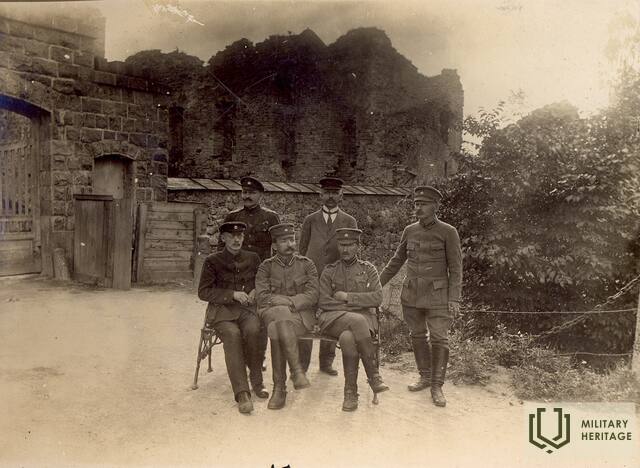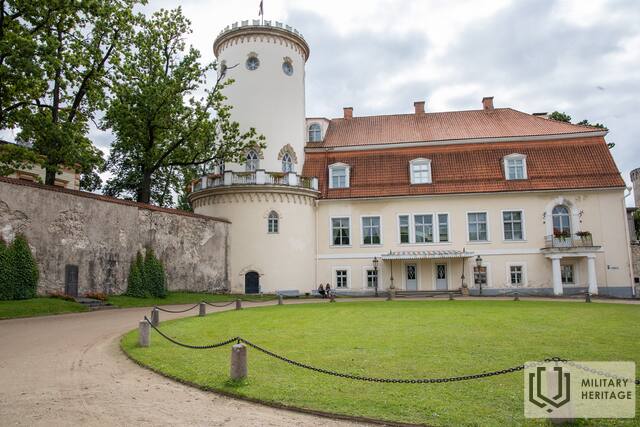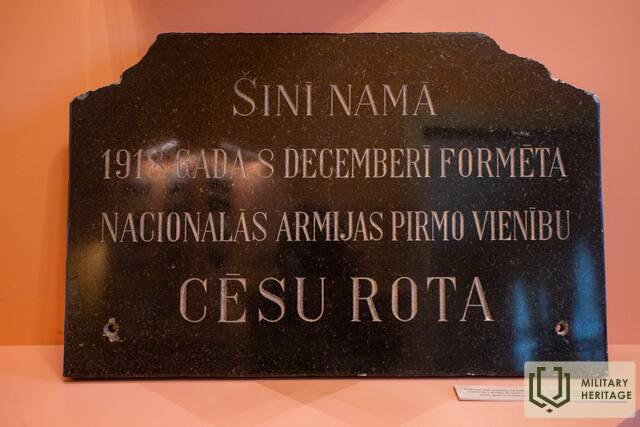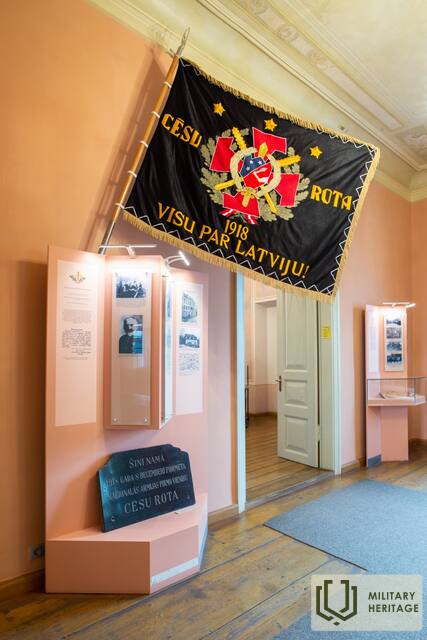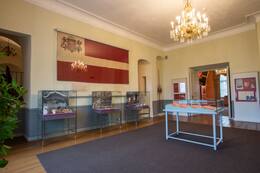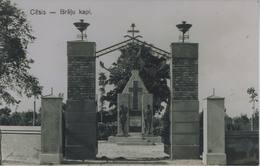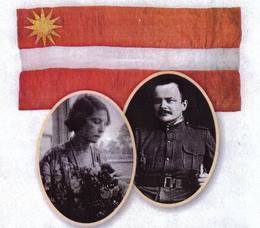Цесисский Новый Замок - стены, в которых была создана безопасность Латвийского государства и документы, удостоверяющие личность, по-прежнему защищены.
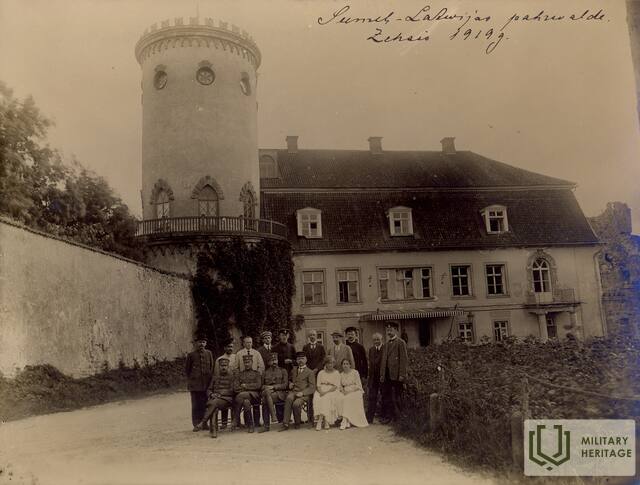
Цесисский Новый замок был построен на военном укреплении - развалинах средневекового замка. Однако это далеко не единственное военное значение постройки.
Прекрасная резиденция графа Зиверса позаботилась не только о безопасности и благополучии своих владельцев и строителей, но и пережила в своих стенах рождение первых формирований Вооруженных сил Латвии. 8 декабря 1918 года здесь была образована Цесисская рота, которая участвовала в первых сражениях Освободительной войны Латвии. Это самые ранние сражения, за которые несколько участников были награждены Военным орденом Лачплесис. Позже украшения попали в так называемый Калпакский батальон, который в 1919 году сражался за освобождение Латвии в Курземе.
В 1919 году Новый Цесисский замок служил убежищем для Временного правительства Латвии Карлиса Улманиса - в замке находится только Гражданская администрация Северной Латвии. Это время, когда Цесис на три дня приобретает значение столичного масштаба.
С 1949 года исторические свидетельства, собранные Цесисским историко-художественным музеем, нашли убежище в стенах Цесисского Нового замка. Благодаря студенческому объединению "Līdums" Цесисский музей с 1933 года является важным хранителем истории латвийского флага. Сотрудники музея не только сохранили столь ценные для нашей страны свидетельства, но и проявили храбрость, чтобы защитить их от разрушения во время советской оккупации: вскоре после окончания Второй мировой войны Эрна Беркхольце, исследователь Цесисского музея, участвовал в изъятии материалов по истории флага из собрания музея. Она берет материалы, которые нужно уничтожить, в дом и сохраняет их. В 1997 году вернула их в музей.
После восстановления независимости Латвии сотрудники музея постоянно работают над исследованием и популяризацией истории флага. В 2000 году историк музея доктор исторических наук. Объемный труд «Красно-бело-красный - цвета латвийского флага. Исследования, воспоминания, документы по истории государственного флага Латвии ». С 2012 года в экспозиции музея истории флага отведено специальное пространство - Зал флага, где также можно увидеть первый латвийский государственный флаг, созданный Янисом Лапиньшем. 2016 год для этого особенный, ведь с момента создания флага прошло 100 лет.
Цесисский историко-художественный музей, 09.11.2016
Связанные темы
Связанные объекты
Выставка Цесисского (Cēsis) музея истории и искусства в Новом замке
Цесисский музей истории и искусства расположен в самом центре Старого города Цесиса – в Новом замке. В музее действует постоянная экспозиция истории и интерьеров «Цесис - символ истории Латвии», состоящая из двух тематических частей: Экспозиция «Красно-бело-красный флаг в истории Цесиса и Латвии» знакомит с историей создания национального флага Латвии с 13 по 20 век, утвержденного как национальный символ, а также флагами батальона Латышских стрелков и традициями использования национальных цветов во время войны за независимость Латвии
Экспозиция «Борьба за свободу Латвии и Цесиса» рассказывает о формировании Цесисской роты в декабре 1918 года, истории совместных эстонско-латвийских сражений в битвах 1919 года за Цесис, когда Цесис на короткое время стал столицей Латвии, истории памятника Победы Цесиса. В квест-комнате участники игры «Легенды Цесисской битвы» должны в течение часа найти выход, решая головоломки, находя взаимосвязи и спрятанные предметы. 8 декабря 1918 года в Цесисском замке была основана одна из первых частей Латвийских вооруженных сил - Цесисская рота, которую сформировал старший лейтенант Артурс Янсонс. 8 декабря 1933 года возле Цесисского Нового замка, где располагались штаб 8-го Даугавпилсского пехотного полка и офицерский клуб гарнизона, была открыта посвященная роте памятная табличка, которую теперь можно увидеть в экспозиции музея.
Кладбище Цесисских братьев
Находится на Цесисском кладбище Леяс, улица Ленчу 15, Цесис.
Одним из важнейших памятных мест Первой мировой и Освободительной войны в Цесисе является Братское кладбище на Нижнем кладбище.
Кладбище является памятником Братского кладбища, построенным в 1927 году цесисским художником и мыслителем Аугустусом Юллой (1872-1958), посвященным солдатам, похороненным на Братском кладбище с 1915 по 1920 годы.
На братском кладбище Цесисского Нижнего кладбища похоронено около 200 воинов. Среди них неизвестное количество латышских стрелков и русских солдат, погибших в Первую мировую войну, а также солдаты немецкой (10), польской и других национальностей. Во время Латвийской освободительной войны на этих кладбищах были похоронены 22 павших солдата 5-го (2-го) Цесисского пехотного полка, а также 11 борцов за свободу, павших в других частях латышской армии. На Братском кладбище похоронены 2 эстонца, 15 жертв большевиков, а также латышские красные стрелки.
Мемориальное место Я. Лапиньша, автора первого флага Латвии
Находится в "Lejas Pintuli", Веселавская волость, Приекульский край.
Можно увидеть памятник Янису Лапинясу, автору пре-флага Латвии.
Государственный флаг Латвии был создан во время Первой мировой войны. В 1915 году при создании знамен латышских стрелковых батальонов некоторые художники предложили знаменосцам красный и белый цвета. Во второй половине 1916 года красно-белый флаг, брошенный педагогом и журналистом Янисом Лапиней, изготовила его ученица Марианна Страумане, учительница приюта для беженцев в Валмиере.
Это первый известный и фактически изготовленный государственный флаг Латвии, сохранившийся до наших дней.
В 2014 году в «Lejas Pintuulis» Веселавской волости Приекульского уезда был открыт памятник Янису Лапинясу, автору префлага.
Первый известный подлинный латвийский государственный флаг, прошедший через коридоры беженцев в России, был тщательно спрятан во время советской и немецкой оккупации и в настоящее время хранится в Цесисском историко-художественном музее . Его подарила в 1997 году их дочь Лия Пога.




